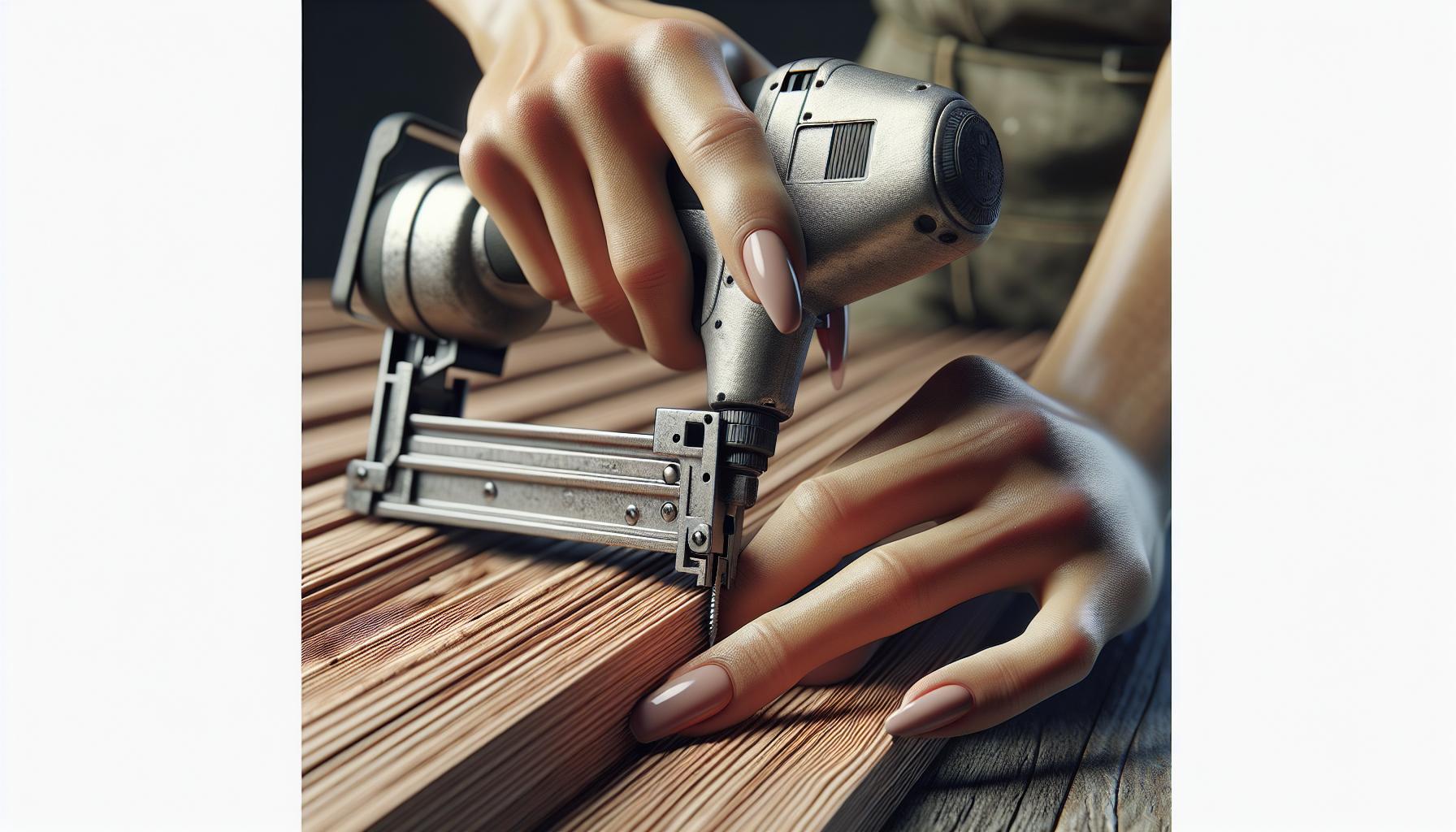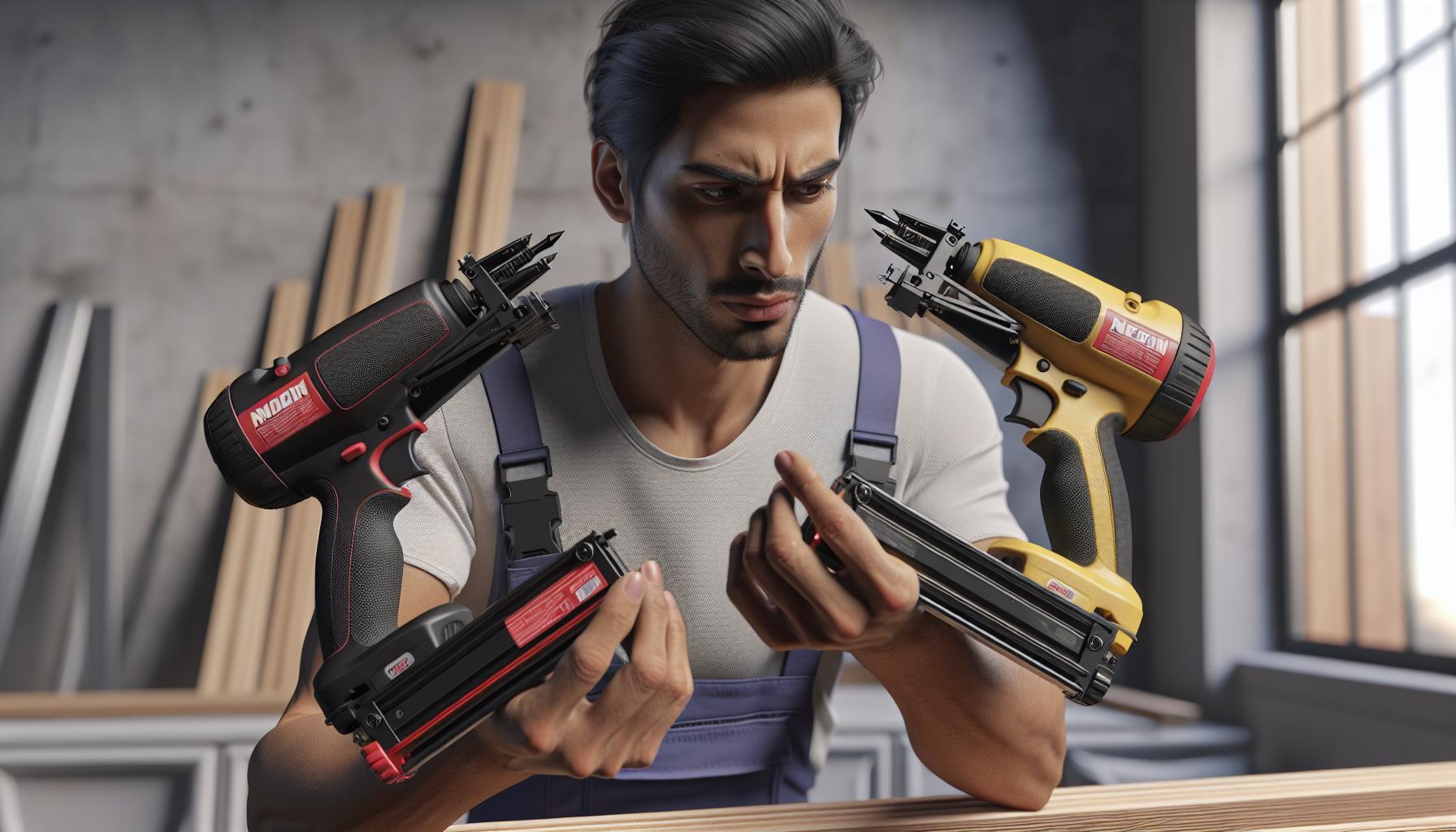When tackling a finish carpentry project, the nailer you choose can make or break your workflow. I’ve had my fair share of experiences with different brands, and two that often come up in discussions are Metabo and Bostitch. Both have their loyalists, and for good reason.
Choosing between Metabo and Bostitch finish nailers isn’t just about price or popularity—it’s about precision, reliability, and how the tool feels in your hands. I’ve used both and I’m here to share insights that’ll help you nail down the right choice for your projects.
Durability and performance are key, and whether you’re a seasoned pro or a DIY enthusiast, the nuances of these tools matter. Stick with me as I dive into the specifics that set Metabo and Bostitch apart in the finish nailer arena.
Overview of Metabo and Bostitch finish nailers
When we dive into Metabo finish nailers, I’m often struck by their commitment to precision. Metabo, formerly known as Hitachi, has a reputation for creating well-balanced tools that provide a comfortable user experience. Their finish nailers are no exception. They’re engineered for fine work, meaning they’re sensitive to the delicate nature of finish carpentry. I’ve personally found their nailers to be reliable and less prone to jamming, a critical factor on any job site.
Bostitch finish nailers, on the other hand, are widely recognized for their durability. Not to say that they aren’t precise – they are, but they seem to be designed with a sturdier build in mind. I’ve noticed a trend among my colleagues who often opt for Bostitch when they’re facing more rugged conditions. The emphasis on toughness does not undermine its capability for detailed work, but it certainly makes a Bostitch a reliable companion for heavier-duty tasks.
Both brands have been at the forefront of incorporating innovative features into their finish nailers. A quick glance at their product line-up reveals a variety of models tailored to specific needs. Metabo nailers often include user-friendly features like selective actuation switches and integrated air dusters, which are incredibly handy for keeping your workpiece clean. Bostitch models commonly sport features like Dial-A-Depth control, giving you the precision to choose exactly how deep you want your nails to be set.
For those who take safety features seriously, it’s reassuring to note that both brands have incorporated necessary precautions. Metabo’s nailers come with shield guards to protect against errant nail discharge, and Bostitch nailers generally have anti-dry fire mechanisms to prevent wear on the tool.
Every tool has its audience, and my experiences with both Metabo and Bostitch finish nailers have convinced me that they cater exceptionally well to their target users. Whether it’s the finesse of fine woodworking or the robustness required for tougher materials, these brands have a solution. What matters most is understanding the specifics of the tasks at hand and choosing a tool that aligns with those requirements.
Precision and reliability: A comparison between Metabo and Bostitch
In the realm of fine carpentry and finish work, precision and reliability aren’t just convenient; they’re imperative. I’ve found that Metabo nailers excel in delivering precise nail placement, which is critical when working with delicate trim and molding. What sets them apart is their unique driving system that seems to mitigate recoil, enhancing precision. Also, the selective actuation switch on Metabo nailers allows me to easily switch between sequential and contact nailing without having to fiddle with additional tools or settings.
Meanwhile, Bostitch’s precision is underpinned by its patented Smart Point technology. This feature offers a smaller nose for clear line of sight and more accurate nail placement, a boon when the aesthetics of the piece are paramount. Plus, Dial-A-Depth control provides an extra layer of customization, which I’ve found invaluable for sinking nails to just the right depth without splitting the wood.
When it comes to reliability, Metabo finish nailers are renowned for their long-lasting performance. They’re designed with fewer jamming issues, which means less downtime and frustration on the job. They feature durable components that withstand the rigors of constant use. Even after years of service, my Metabo nailer remains a steady performer, firing nails true and without fail.
Bostitch finish nailers, on the other hand, are practically synonymous with toughness. They’re constructed with a rugged build, often featuring magnesium components for a solid yet manageable tool. The anti-dry fire mechanism is particularly reliable, helping to prevent workpiece damage and preserving the nailer’s integrity. I’ve dropped my Bostitch nailer more times than I care to admit, but it soldiers on without a hitch, a testament to its sturdiness.
Throughout my experience, I’ve learned that the real-world performance of Metabo and Bostitch nailers goes beyond just specifications. It’s their consistent execution on the field that builds trust. Whether it’s Metabo’s seamless operation or Bostitch’s enduring build, these brands have earned their stripes in the woodworking community.
Durability and performance: How Metabo and Bostitch stack up
When I’m analyzing the resilience of finish nailers, I take a close look at how they endure through demanding projects and frequent use. In my experience, Metabo’s finish nailers boast a hardy aluminum body that not only reduces weight for ease of handling but also stands up to the rough-and-tumble of a job site. They’ve got a reputation for being tough cookies, with users often reporting years of reliable service without major repair needs.
Bostitch, not to be outdone, has also crafted their nailers with durability in mind. They typically feature a magnesium body which is known for its strength-to-weight ratio. It’s not just the external casing that’s robust; their internal components are designed to withstand wear and tear. I’ve seen many Bostitch nailers still performing well after extensive use, surviving drops and knocks that are part and parcel of daily work.
But Let’s talk numbers. While I don’t have a statistical failure rate to share, user testimonials and my time on job sites indicate that both brands hold up impressively under pressure. And when it comes to performance, both brands deliver with their own set of merits.
- Metabo nailers are engineered for consistent drives and have a track record of fewer misfires.
- Bostitch nailers aren’t shy about performance either, known for their quick recovery times and efficient nailing cycles.
The proof, as they say, is in the pudding—or in this case, the performance. Metabo’s efficient driving system makes them a joy to use on long jobs where fatigue can set in. Bostitch counters with their nailers’ capacity to churn out quick work, making them ideal for high-volume tasks. What’s clear is that these tools are built to perform, and both companies have optimized their products to meet the high standards of professional woodworkers and DIY enthusiasts alike.
Ergonomics and comfort: Which finish nailer feels better in your hands?
When working on a project, comfort can be just as crucial as the tool’s performance. Nobody wants to end the day with aching hands. That’s why ergonomics play a vital role in choosing the right finish nailer. Let’s dive into how Metabo and Bostitch stand on this front.
Metabo finish nailers are designed with a user-centric approach. I’ve noticed the rubber grip feels secure and comfortable, even during prolonged use. It’s all in the details—the grip’s pattern reduces slippage, and the weight is evenly distributed to minimize wrist strain. This balanced design helps avoid fatigue, allowing me to work longer without taking a break.
With Bostitch, the focus on comfort is evident as well. Their nailers feature a molded rubber grip that conforms nicely to the hand. What I find impressive is how light they feel. Bostitch nailers often weigh less than their Metabo counterparts, thanks to their magnesium construction. This weight reduction is a boon for overhead and extended tasks.
Maneuverability is another aspect to consider. I’ve handled both brands and can say they provide excellent control. However, I’ve found that Metabo’s narrow body is advantageous when fitting into tight spaces. In contrast, Bostitch nailers have a tendency to be a bit bulkier, which might be a slight inconvenience in compact spots.
Vibration is a sneaky factor that can impact comfort. Both brands have made strides in reducing vibration, but my experience leans towards Metabo here—they seem to have an edge in vibration dampening. This is critical for maintaining precision and reducing the jarring impact on your hands after hundreds of nails.
Ultimately, the best way to gauge ergonomics is by testing the nailers yourself. Personal preference plays a significant role, and what feels good in my hands may differ for another. Therefore, I always recommend visiting a local dealer or borrowing a nailer from a buddy to get a true feel for comfort and ease of use.
Conclusion: Making the right choice between Metabo and Bostitch
Choosing the ideal finish nailer boils down to your specific needs and preferences. I’ve found that Metabo’s user-friendly design and vibration dampening give it a slight advantage in comfort, especially for prolonged use. Yet Bostitch’s lighter weight and ergonomic build shouldn’t be overlooked. It’s clear that both brands have their merits and it’s crucial to weigh them against the demands of your projects. I recommend getting hands-on experience with both to see which nailer feels right for you. After all, the best tool is the one that not only performs to your expectations but also feels like a natural extension of your hand.
Frequently Asked Questions
What are the main differences between Metabo and Bostitch finish nailers?
Metabo finish nailers are designed with a narrower body and a secure rubber grip for better ergonomics, while Bostitch nailers feature a magnesium construction leading to lighter weight and have a molded rubber grip for comfort.
Which finish nailer is more durable?
The article doesn’t explicitly state which brand is more durable. It focuses on ergonomic features and durability might be inferred from the overall construction and performance of the nailers, which would require specific testing or user reviews to determine.
Are Metabo nailers more ergonomic than Bostitch nailers?
Metabo nailers are described as having a user-centric design with a comfortable rubber grip that reduces slippage and wrist strain, which may suggest superior ergonomics over Bostitch nailers.
Can Bostitch finish nailers fit into tight spaces?
While Bostitch finish nailers are designed with comfort in mind, they are noted to be slightly bulkier. Metabo nailers have the advantage of a narrower body, which is better suited for tight spaces.
Which nailer has better vibration dampening?
The author suggests that Metabo nailers might have an edge in vibration dampening, although this is based on the article’s leanings and not directly on comparative data.
Is it better to test finish nailers before purchasing?
Yes, the author recommends testing the nailers oneself to determine personal comfort, ergonomics, and ease of use since these factors can be subjective.



Reader Interactions